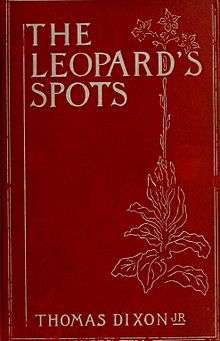The Leopard's Spots
The Leopard's Spots: A Romance of the White Man's Burden—1865–1900 is the first novel of Thomas Dixon's Ku Klux Klan trilogy, and was followed by The Clansman: A Historical Romance of the Ku Klux Klan (1905), and The Traitor: A Story of the Fall of the Invisible Empire (1907).[1] In the novel, published in 1902, Dixon offers an account of Reconstruction in which he portrays a Reconstruction leader (and former slave driver), Northern carpetbaggers, and emancipated slaves as the villains; Ku Klux Klan members are heroes. While the playbills and program for The Birth of a Nation claimed The Leopard's Spots as a source in addition to The Clansman, recent scholars do not accept this.[2][3]
 First edition cover | |
| Author | Thomas Dixon |
|---|---|
| Illustrator | C. D. Williams |
| Country | United States |
| Language | English |
| Genre | Novel |
| Publisher | Doubleday, Page & Co. |
Publication date | 1902 |
| Media type | |
| OCLC | 12852953 |
A passage from the Book of Jeremiah (13:23) is included on the title page: "Can the Ethiopian change his skin, or the leopard his spots?" The title conveyed the idea that as leopards could not change their spots, people of African origin could not change what Dixon, as a racist and white supremacist,[1] viewed as inherently negative character traits.
A reply to Uncle Tom's Cabin
Harriet Beecher Stowe's landmark novel of 1852, Uncle Tom's Cabin; or, Life Among the Lowly, had a profound effect on attitudes toward African Americans and slavery in the U.S. and is said to have "helped lay the groundwork for the Civil War".[4] It was still widely read fifty years after its publication. According to Dixon, whose contact with the work was a dramatized version, Stowe "grossly misrepresent[ed]" the American South, and he felt her sympathetic portrayal of African Americans demanded revision. So as to make it clear he is answering Stowe, he presents his version of Stowe's characters, using Stowe's character names.[5]
Characters
Using names of characters in Uncle Tom's Cabin
- Simon Legree – Ex-slave driver and Reconstruction leader
- Tom Camp – In Stowe's novel Tom (no last name) is a humble African-American slave and "Mr. Shelby's best hand". Dixon's Tom is a former Confederate soldier, a poor white Christian whose family is victimized by black men.
- Hon. Tim Shelby – Political boss. In Uncle Tom's Cabin Arthur Shelby was Tom's owner, who "sold him South". His son George Shelby is also a character.
- George Harris, Jr – An educated negro
Other characters
- Charles Gaston – A man who dreams of making it to the Governor's Mansion
- Sallie Worth – A daughter of the old-fashioned South
- Gen. Daniel Worth – Sallie Worth's father
- Mrs. Worth – Sallie's mother
- The Rev. John Durham – A preacher who threw his life away
- Flora – Tom's daughter
- Allan Mcleod – A scalawag (Union sympathizer)
- Everett Lowell – Member of Congress from Boston
- Helen Lowell – Everett's daughter
- Major Stuart Dameron – Head of the Ku Klux Klan
- Hose Norman – poor white man
- Leonidas
Dramatization
A dramatization by Dixon, with the same title, was produced in New York in 1913.[6]:70
References
- Leitner, Andrew, Thomas Dixon, Jr.: Conflicts in History and Literature, Documenting the American South, University Library, University of North Carolina at Chapel Hill, retrieved May 6, 2019
- Merritt, Russell (Autumn 1972). "Dixon, Griffith, and the Southern Legend". Cinema Journal. 12 (1).
- Crowe, Karen (1984). "Preface". In Crowe, Karen (ed.). Southern horizons : the autobiography of Thomas Dixon. Alexandria, Virginia: IWV Publishing. pp. xvii–xviii. OCLC 11398740.
- Kaufman, Will (2006). The Civil War in American Culture. Edinburgh University Press. p. 18. ISBN 9780748619351.
- Larson, Jennifer L.; Kirkpatrick, Mary Alice. "Summary [of The Leopard's Spots]". Documenting the American South. University Library, University of North Carolina at Chapel Hill. Retrieved June 4, 2019.
- Slide, Anthony (2004). American Racist: The Life and Films of Thomas Dixon. Lexington, Kentucky: University Press of Kentucky. ISBN 0-8131-2328-3.
Further reading
- Bloomfield, Maxwell. "Dixon's "The Leopard's Spots": A Study in Popular Racism," American Quarterly, Vol. 16, No. 3 (Autumn, 1964), pp. 387–401 in JSTOR
External links
- Full text of The Leopard's Spots, Documenting the American South, University of North Carolina